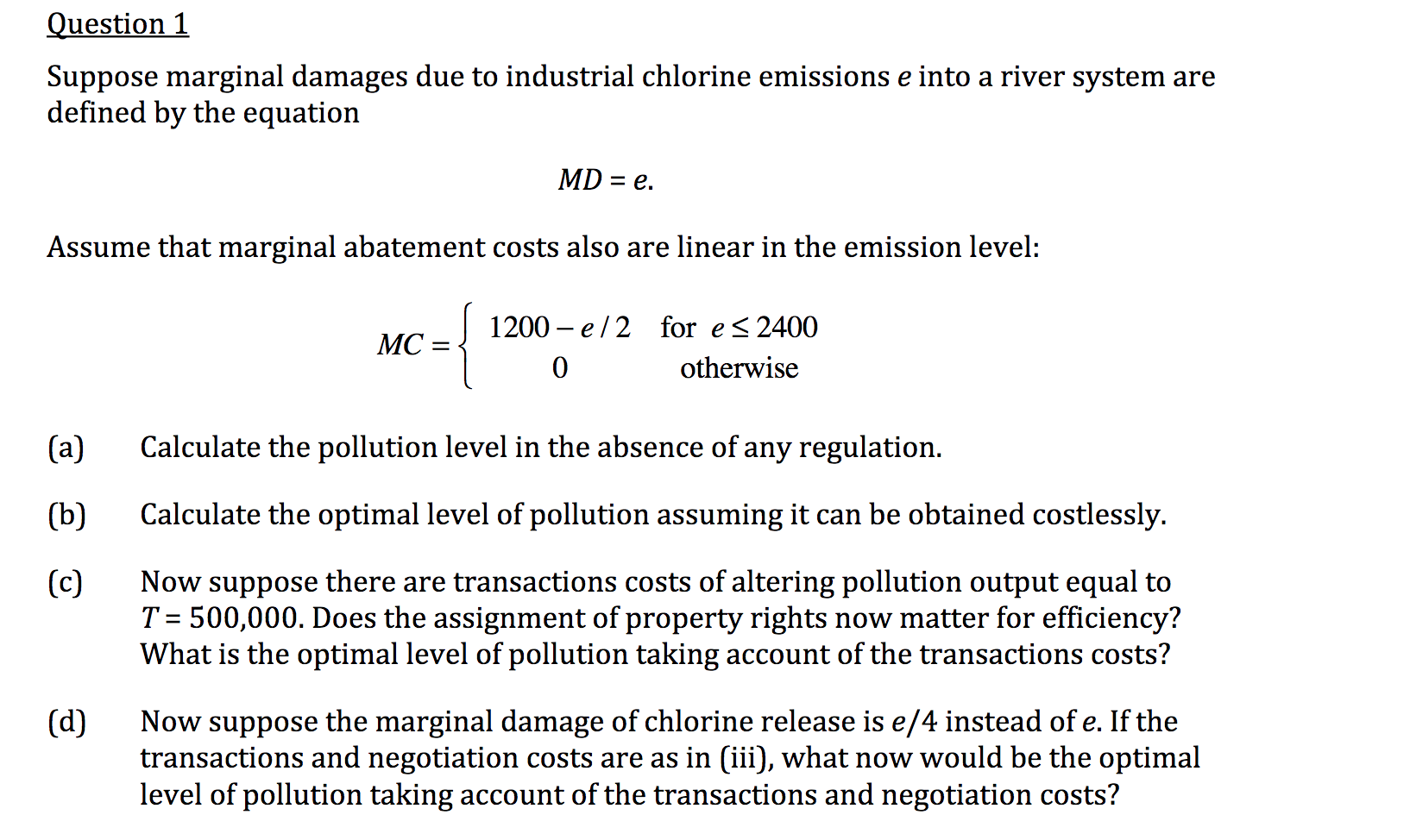Suppose marginal damages due to industrial chlorine emissions e into a river system are defined by the equation MD = e. Assume that marginal abatement costs also are linear in the emission level: 1200 – e/2 for e<2400 MC = otherwise (a) Calculate the pollution level in the absence of any regulation. (b) Calculate the optimal level of pollution assuming it can be obtained costlessly. Now suppose there are transactions costs of altering pollution output equal to T = 500,000. Does the assignment of property rights now matter for efficiency? What is the optimal level of pollution taking account of the transactions costs? (c) Now suppose the marginal damage of chlorine release is e/4 instead of e. If the transactions and negotiation costs are as in (iii), what now would be the optimal level of pollution taking account of the transactions and negotiation costs? (d)
Suppose marginal damages due to industrial chlorine emissions e into a river system are defined by the equation MD = e. Assume that marginal abatement costs also are linear in the emission level: 1200 – e/2 for e<2400 MC = otherwise (a) Calculate the pollution level in the absence of any regulation. (b) Calculate the optimal level of pollution assuming it can be obtained costlessly. Now suppose there are transactions costs of altering pollution output equal to T = 500,000. Does the assignment of property rights now matter for efficiency? What is the optimal level of pollution taking account of the transactions costs? (c) Now suppose the marginal damage of chlorine release is e/4 instead of e. If the transactions and negotiation costs are as in (iii), what now would be the optimal level of pollution taking account of the transactions and negotiation costs? (d)
Microeconomics A Contemporary Intro
10th Edition
ISBN:9781285635101
Author:MCEACHERN
Publisher:MCEACHERN
Chapter17: Externalities And The Environment
Section: Chapter Questions
Problem 13PAE
Related questions
Question
100%

Transcribed Image Text:Suppose marginal damages due to industrial chlorine emissions e into a river system are
defined by the equation
MD = e.
Assume that marginal abatement costs also are linear in the emission level:
1200 – e/2 for e<2400
MC =
otherwise
(a)
Calculate the pollution level in the absence of any regulation.
(b)
Calculate the optimal level of pollution assuming it can be obtained costlessly.
Now suppose there are transactions costs of altering pollution output equal to
T = 500,000. Does the assignment of property rights now matter for efficiency?
What is the optimal level of pollution taking account of the transactions costs?
(c)
Now suppose the marginal damage of chlorine release is e/4 instead of e. If the
transactions and negotiation costs are as in (iii), what now would be the optimal
level of pollution taking account of the transactions and negotiation costs?
(d)
Expert Solution
This question has been solved!
Explore an expertly crafted, step-by-step solution for a thorough understanding of key concepts.
This is a popular solution!
Trending now
This is a popular solution!
Step by step
Solved in 3 steps

Knowledge Booster
Learn more about
Need a deep-dive on the concept behind this application? Look no further. Learn more about this topic, economics and related others by exploring similar questions and additional content below.Recommended textbooks for you





